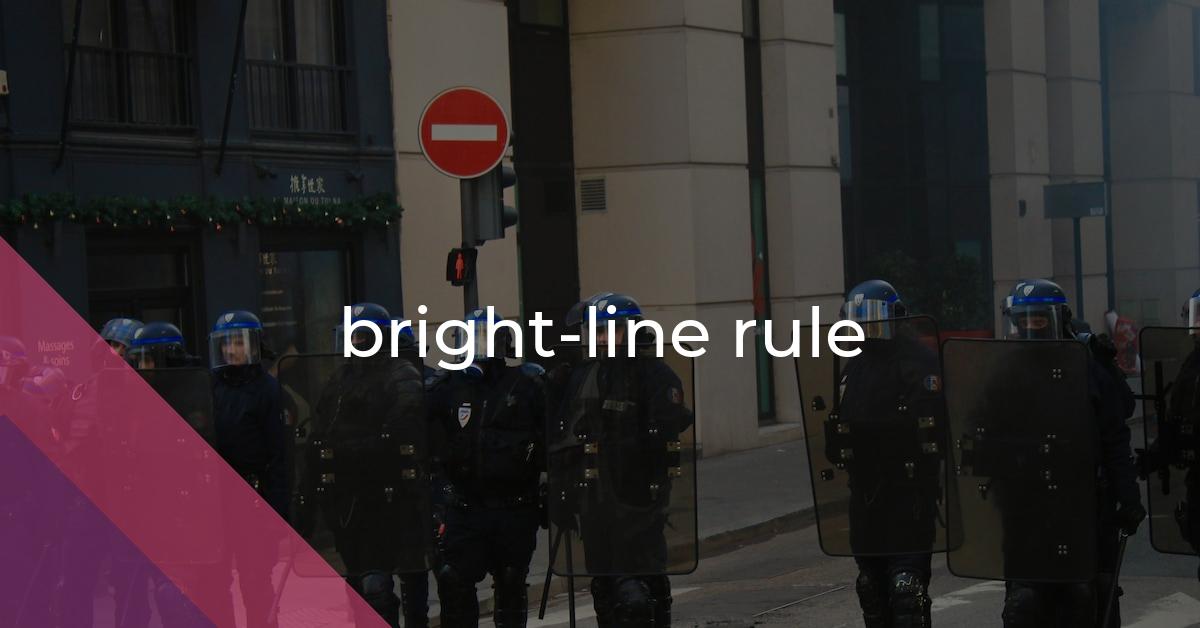bright-line rule: Idiom Meaning and Origin
What does ‘bright-line rule’ mean?
A bright-line rule is a clear and unambiguous standard that leaves no room for interpretation or discretion. It provides a straightforward and easily applicable guideline or boundary in different areas or contexts.

Idiom Explorer
The idiom "line in the sand" refers to a boundary or limit that is clearly set and should not be crossed. It is often used to indicate a firm stance or position on an issue.
The idiom "draw the line" means to set a limit or establish a boundary beyond which one is unwilling to go or accept.
The idiom "draw a straight furrow" means to do something in a methodical and systematic manner, without deviating or making mistakes.
The idiom "draw a line" means to set a limit or establish a boundary, indicating the point where one thing ends and another begins.
The idiom "cutting edge" refers to being at the forefront of innovation or advancement in a particular field or industry.
"Cut red tape" means to remove unnecessary bureaucracy or excessive rules and regulations in order to simplify a process or make it more efficient.
The idiom "crystal clear" means something that is extremely clear, transparent, or easily understood.
The idiom "clear one's lines" means to remove any obstacles or distractions, allowing one to focus on the task at hand without any interruptions.
The idiom "clear cut" means something that is very obvious, straightforward, or easy to understand. It refers to a situation or decision that lacks complexity or ambiguity.
Deciphering Clarity: Unveiling *bright-line rule* Definition
The idiom "bright-line rule" is a legal term that originated in the United States. It refers to a clear and unambiguous rule or standard that does not require interpretation or discretion. The term is often used in the field of law, particularly in the context of constitutional law and administrative law.
One of the key aspects of the bright-line rule is its clarity and lack of flexibility. It provides a clear-cut guideline or threshold that can be easily applied to various situations, eliminating the need for subjective judgments or discretion. This makes it particularly useful in areas of law where predictability and consistency are crucial.
The term "bright-line rule" is believed to have originated in the early 20th century, although its exact first usage is unclear. It gained prominence in legal discourse and has since become a well-established concept in the legal field.
In constitutional law, the bright-line rule is often invoked in cases dealing with fundamental rights and liberties. The use of bright-line rules in these cases aims to provide a clear and objective standard for evaluating government actions or restrictions that may infringe upon these rights. For example, the Supreme Court has applied bright-line rules in cases related to free speech, where it has outlined specific categories of speech that are not protected under the First Amendment.
In administrative law, the bright-line rule is utilized to establish clear standards for government agencies and their decision-making processes. These rules help ensure fairness, consistency, and prevent arbitrary decision-making. They are often applied in areas such as rulemaking, licensing, and enforcement.
While the bright-line rule offers the benefits of clarity and predictability, it also has limitations. Some argue that the inflexible nature of bright-line rules can result in unjust outcomes in certain cases. Critics argue that these rules may not account for the nuances and complexities of individual situations, resulting in unfairness or unintended consequences.
The idiom "bright line" is closely related to the bright-line rule. It is often used to describe a clear and distinct boundary or demarcation between two things. In legal contexts, it can refer to a clear and unambiguous rule or standard that is easy to follow and understand. Just like the bright-line rule, the idiom "bright line" emphasizes clarity and lack of ambiguity.
Another related idiom is "black-and-white-idiom-meaning-and-origin/">black and white." It is often used to describe situations or issues that are clear-cut and devoid of any gray areas or ambiguity. In the legal context, "black and white" can refer to a clear and objective standard or rule that does not require interpretation. This idiom emphasizes the absence of ambiguity and the presence of clear distinctions.
The idiom "line in the sand" is also related to the bright-line rule. It is often used to describe a clear boundary or limit that should not be crossed. In legal contexts, "line in the sand" can refer to a clear rule or standard that must be followed without any exceptions. This idiom emphasizes the firmness and non-negotiable nature of the rule.
The phrase "black-and-white" is yet another idiom related to the bright-line rule. It is often used to describe situations or things that are clear-cut and leave no room for interpretation or ambiguity. In legal contexts, "black-and-white" can refer to a clear and straightforward standard or rule that is easy to understand and apply. This phrase highlights the absence of ambiguity and the presence of clear distinctions.
Overall, the bright-line rule is a well-established legal concept that provides clear and unambiguous guidelines in various areas of law. Its use can help promote consistency, predictability, and fairness. However, it is essential to recognize its limitations and consider the potential need for flexibility or discretion in certain circumstances.
Example usage
Examples of how the idiom *bright-line rule* can be used in a sentence:
- 1. The judge applied a bright-line rule, stating that anyone caught exceeding the speed limit by more than 20 miles per hour would automatically have their license suspended.
- 2. The company implemented a bright-line rule to prevent conflicts of interest, prohibiting employees from accepting gifts of any value from clients.
- 3. The university established a bright-line rule regarding plagiarism, stating that any form of academic dishonesty would result in immediate expulsion.
More "Law" idioms



